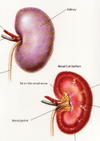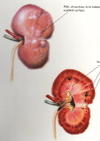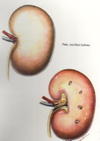 Here’s a portrait of a nice, healthy kidney, but that’s not the kind we’re talking about. We are talking about pets with kidney failure. Does that mean "it’s over"? Maybe yes, maybe no. Kidney failure (or renal failure, as we scientific types like to say) can be acute or chronic. "Renal failure" means that the kidneys are not working well enough to clear waste from the bloodstream. We measure BUN, creatinine, and phosphorus levels (among other things). The patient may be producing lots of urine (or not), but when these wastes rise above normal levels, we know the kidneys aren’t working well.
Here’s a portrait of a nice, healthy kidney, but that’s not the kind we’re talking about. We are talking about pets with kidney failure. Does that mean "it’s over"? Maybe yes, maybe no. Kidney failure (or renal failure, as we scientific types like to say) can be acute or chronic. "Renal failure" means that the kidneys are not working well enough to clear waste from the bloodstream. We measure BUN, creatinine, and phosphorus levels (among other things). The patient may be producing lots of urine (or not), but when these wastes rise above normal levels, we know the kidneys aren’t working well.
BUN is Blood Urea Nitrogen, a waste-product that can fluctuate rapidly in the course of a day, being influenced even by how much you eat and drink. It still shouldn’t get much above 30. It can rise to double or triple that value, or even more. Creatinine levels change slowly, over a period of days, and phosphorus levels don’t start creeping up until the kidneys have really gone south.
This could be chronic — the culmination of a long-standing, slow deterioration, and there is just not much functional kidney tissue left. Or it could be acute – the kidneys just suddenly got sick; they aren’t functioning, but they are not destroyed, either, and they could get well. Sometimes the only way to find out is to treat the patient and see if they respond.
You start out with about four times as much kidney capacity as you need. You could get by with half of one healthy kidney, and you have two whole ones. Thus, you could have a slow, gradual long-term destruction of the organs. Until you get down below 25% of kidney tissue, you still feel okay. Even when you get below 25%, your body can stand the increased levels of waste and become accustomed to them. When these guys finally get sick enough to quit eating, when they get nauseated and start throwing up, they are beyond saving. BUN is 100, other values up, and things don’t look good.
On the other hand, the kid whose kidneys shut down because of an infection will be just as sick, and his numbers may be just as bad. Yet, with appropriate treatment he could get well.
 How do we know whether your pet’s kidney disease is acute or chronic? Can you tell by looking at the dog? This dog looks pretty good, beautiful hair coat, but she has lousy numbers – very high levels of waste in her blood. She looks awfully good, but her kidneys don’t look so good.
How do we know whether your pet’s kidney disease is acute or chronic? Can you tell by looking at the dog? This dog looks pretty good, beautiful hair coat, but she has lousy numbers – very high levels of waste in her blood. She looks awfully good, but her kidneys don’t look so good.
 When we ultrasounded her kidneys, they looked shrunken and misshapen, as in this diagram. Her owners wanted to treat her, even though her prognosis didn’t look good. Intensive fluid and diuretic therapy were instituted, but she just did not respond. She couldn’t respond, as she just didn’t have the functional kidney tissue. Things won’t always be that clear-cut, though. Sometimes the kidneys really won’t look bad on the ultrasound, even though the damage may be severe and irreversible, whether chronic or acute.
When we ultrasounded her kidneys, they looked shrunken and misshapen, as in this diagram. Her owners wanted to treat her, even though her prognosis didn’t look good. Intensive fluid and diuretic therapy were instituted, but she just did not respond. She couldn’t respond, as she just didn’t have the functional kidney tissue. Things won’t always be that clear-cut, though. Sometimes the kidneys really won’t look bad on the ultrasound, even though the damage may be severe and irreversible, whether chronic or acute.
 This little dog doesn’t look nearly as healthy as the last one, and she is several years older, and she had lousy numbers when she came in.
This little dog doesn’t look nearly as healthy as the last one, and she is several years older, and she had lousy numbers when she came in.
 Her ultrasound looked okay, but that was no guarantee. This is a sick kidney, but it hasn’treally changed shape. This dog is a classic illustration of the principle that sometimes the only way to tell if a patient is treatable is to treat them. In this case, we also saw evidence of kidney infection in her urine specimen, so we hoped that intensive therapy with I.V. fluids and antibiotics might turn her around.
Her ultrasound looked okay, but that was no guarantee. This is a sick kidney, but it hasn’treally changed shape. This dog is a classic illustration of the principle that sometimes the only way to tell if a patient is treatable is to treat them. In this case, we also saw evidence of kidney infection in her urine specimen, so we hoped that intensive therapy with I.V. fluids and antibiotics might turn her around.
 And so it did. Here she is the next day, feeling great, and eating, and she is still trucking along months later. If we had tried to "tell by looking", I’d have given her up. I’m glad we gave her our best.
And so it did. Here she is the next day, feeling great, and eating, and she is still trucking along months later. If we had tried to "tell by looking", I’d have given her up. I’m glad we gave her our best.

